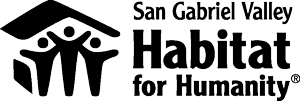SGV Habitat History
In 1990, friends, old and new, with a shared belief in empowering the dreams of others began a journey to establish what today is San Gabriel Valley Habitat for Humanity. Over 30 years later we continue to inspire the community to empower the dreams of others and to address the growing need for affordable housing – especially affordable homeownership – in our communities.
The first meeting for a local chapter of Habitat for Humanity was held at St. Andrew’s School in Pasadena on May 18, 1989. Approximately 40 people were in attendance to discuss the idea of bringing Habitat for Humanity to Pasadena and if they would participate in an upcoming big event. The event planned for June 1990 (with former President Jimmy Carter) was a walk from Pasadena to Tijuana. 75 walkers ended up participating in this event as they made the trek from Pasadena to Tijuana where 100 houses were being built in one week (the Jimmy Carter Work Project).
(See the LA Times Article written about this event: Journey Leads to Homes for Poor)
Following the success of this effort, SGV Habitat’s founders entered into a covenant with Habitat for Humanity International and in 1990 a new Habitat affiliate in the San Gabriel Valley and northeast Los Angeles County was created. In 1990 the median home price for LA County was $212,855 – the first home SGV Habitat built was built in Pasadena on land directly purchased by this affiliate (it was also the first Habitat for Humanity home built in Los Angeles County). In 2012 this homeowner became the first in LA County to payoff her $88,490 mortgage (See the Pasadena Star-News: First Habitat homeowner in L.A. County becomes first to own free and clear).
first 5 years
For 14 years, San Gabriel Valley was primarily volunteer-run and built an average of 1-2 homes per year. Over the next five years that increased and by its 20th year our affiliate was building an average of 5 homes per year. At this time San Gabriel Valley Habitat for Humanity had matured from a small, volunteer-run affiliate to a professional organization with significant capacity to provide meaningful affordable housing solutions and positively impact the San Gabriel Valley.
In 2003, the first ReStore (called Builders Surplus at the time) was opened in Pasadena. By 2010, SGV Habitat had completed 54 homes in the San Gabriel Valley, improving the lives of nearly 300 parents and children.
next 10 years
Over the next 10 years, San Gabriel Valley Habitat for Humanity built 25 more homes and continued to operate two ReStores. We also expanded the Brush with Kindness program to full home repairs (and in 2022 celebrated 100 completed home repairs).
While 2020 marked a slow-down for everyone as the worldwide COVID pandemic forced shut-downs and caused delays for many of our projects you can see that we continued to work towards solutions for the serious affordable housing problem in California.
SGV Habitat managed to serve 9 more families from 2020-2022 with affordable homeownership opportunities.
we're still growing
In fiscal year 2023, SGV Habitat opened a new San Gabriel Valley liquidation center – the Pasadena ReStore, partnered with volunteers who contributed 24,400 volunteer hours, sold 6 homes to first-time homebuyers and completed 27 home preservation projects. 2023 also marked the successful completion of the Expanding the American Dream Campaign. This transformed the lives of 100 families, here and abroad, through affordable homeownership and home preservation over 3 years.
With the successful completion of Expanding the American Dream, San Gabriel Valley Habitat for Humanity announced a new campaign, Framing the Future, that will change the lives of 200 families throughout 31 communities over the next 3 years (2024-2026).
Framing the Future will highlight the immense need for affordable places to live while celebrating the diverse ways SGV Habitat is finding solutions to our local housing crisis – through increasing housing production, affordable home preservation and sustainable practices such as operating resale stores to keep materials out of landfills.





